Baga Beach
Text by Susie Parr, photographs by Martin Parr.
The northern end of Baga Beach curves into a sandy palm-fringed estuary, where the heron waits and fishermen sort their nets in still water. An earth path winds from the rough concrete road bridge through an area of scrubland lined with beached boats, past a small temple, a pay toilet and a few ramshackle stalls selling swimwear – mainly bathing trunks, as the majority of bathers are men. The path is choked with empty bottles, discarded cigarette packs, dirty nappies, plastic bags. Cows sniff at the piles of smoking, malodorous trash then lumber slowly onwards in their unending search for grass; feral dogs pant in the shade. After this inauspicious start the open vista of the beach is a welcome sight: miles of white sand, green-blue sea, the water’s edge lined with rows of sun beds and umbrellas, cafes and restaurants ranged behind. The inland odours and oppressive heat are dispelled by Baga’s lively breeze.
Tramping along, feet already burning on the hot sand, the visitor checks out the prices of beds and umbrellas; these range from 150 rupees per day to free if you buy a drink at the host cafe. All along the waterfront, litter from the previous day has been swept into small, regularly spaced piles. The empty beer bottles, cigarette packs, water bottles and plastic straws are slowly gathered up and – for a while – the sand is clean. At 10 o’clock the lifeguards arrive, assessing conditions and putting up appropriate flags. The beach has big waves, a strong undertow and powerful rip tides. At the first sign of a sinister current, the life guards set up a vigorous chorus of whistles and gestures, waving to the bathers bobbing in the surf, urging them to move to the left or the right, out of danger. Sometimes instructions are relayed through a loudspeaker fixed atop a red jeep. It is impossible to ignore this noise and people obediently shift, like flotsam swept to one side or the other by the lifeguard’s hand. Bizarrely, given their diligence, the guards seem oblivious to the antics of jet skiers who race up and down parallel to the beach, swerving dramatically to a halt often within inches of the bathers, Their indifference may be because such tactics are common on Indian roads, where vehicles veer from lane to lane at high speed, squeezing between lorries, buses, tuk tuks, ox carts, tractors, and scooters bearing entire families including infants.
As regards the water, the lifeguards’ caution is not excessive, as it seems few Indians can actually swim. Rather, they spill into the water and frolic in the surf, waiting for the waves to break over them, shrieking excitedly. The bathers are mostly groups of young men, most clad only their underpants, shouting, splashing, climbing on each other’s shoulders and generally engaging in boistrous displays of horseplay. Few Indian women enter the water; those who do are more cautious and modest, fully clothed in sari, shalwar kameez or even jeans and tee shirt, holding hands with a sister or cousin or hanging on the husband’s arm. Bathers of both sexes lift small children above the waves, dip bare toes in the water, a lifetime of surf-jumping ahead. Few venture out of their depth. As the day wears on the groups become increasingly raucous, shouting excitedly, engaging in rough and tumble and crazy games of tag. These high spirits increase in proportion to the beer consumed, bottle after bottle downed as the sun reaches its highest point then starts to decline. In the hazy late afternoon light, some young men are staggering, some lie giggling at the water’s edge, some throwing sand. Impaired judgement means that many cell phones are ruined by the group selfie in the waves.
Away from this good natured mayhem, older people chat sedately on sun beds, watch movies on tablet or phone, discuss the cricket, and doze. Men stroll along the sand, arms loosely draped across shoulders or hand in hand, deep in conversation. Europeans, some lavishly tattooed, some sporting lurid patches of sunburn, stroll along at the water’s edge or stretch out on towels on the sand to roast some more. Many congregate at a favoured restaurant, where they have their usual sun bed and are on first name terms with the owner, their customary beer served before they need to ask. Sparrows hop on the sand looking for dropped crumbs; dogs slump in the umbrella shade or crawl under the sunbeds. Vendors pass along the sand offering ice cream, selfie stick, small drum, pineapple, water melon, necklace, head massage, coconut, foot massage. As the afternoon fades, more groups arrive into the crowded car park, spilling onto the beach for the spectacle of sunset. The lifeguards clear the water before going off duty. The fishermen push and heave their boats up the estuary channel to the landing stage where they stand in the dusk patiently untangling their catch, fish by shining fish, silver bounty piled into woven baskets. The crows arrive to roost. Overhead, kites wheel on the thermals, searching for scavenge in the last of the light.
When darkness falls, Baga adapts swiftly to night life, a romantic setting for the many honeymooning couples who stay here. Sun beds and umbrellas are stacked away. In their place, tables and chairs are set on the sand, candles lit. Waiters hover. The sand is lit with arc lights and by the illuminations that drape the beach front, pulsing and multi coloured. Some bars create intimate booths on the sand, white curtains lit to a glowing red. Music pounds from speakers. The beach is still full of people, cabals of young men sitting on the sand drinking, some still bobbing in the shallows as the waves break white in the darkness. Now is the toddlers’ time. In the cool of the evening young children can play happily in the sand, mum and dad sitting close by, gazing at the crashing sea. Vendors capitalise on this young market, hawking illuminated toys that spin, whizz and glow. Aside from these small families and the dreamily drifting couples, the majority of hookah smokers and restaurant goers is made up of groups of men, generally older. It is very unusual to see women take a table and make an order, as many will be doing in the foreigners’ enclaves further down the beach. At Manu’s, Sunday night is disco night; posses of young men – and one or two young women – thrash around to Indian house music.
On the beach, a young bull wanders restlessly between the strollers; they move cautiously out of his path, avoiding his mad stare. Empty beer bottles accumulate on the sand. Some bars show cricket (India vs South Africa) or football (Delhi vs Goa). Groups of men sit on plastic chairs, absorbed in the commentary, their backs to the sea. Across the estuary, on the rocky headland, the chapel cross lights up, a still, electric blue.

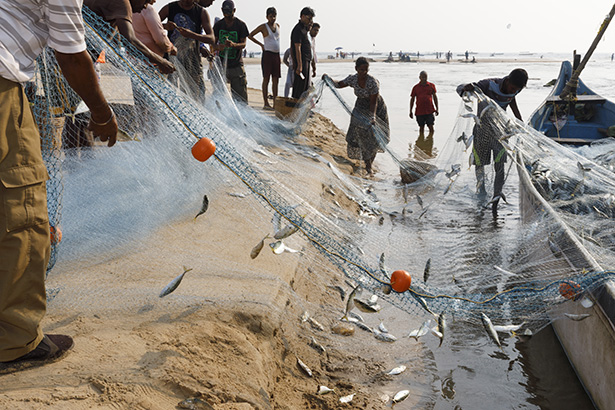
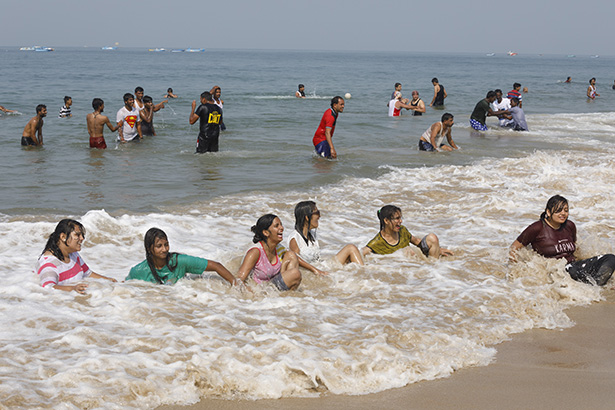
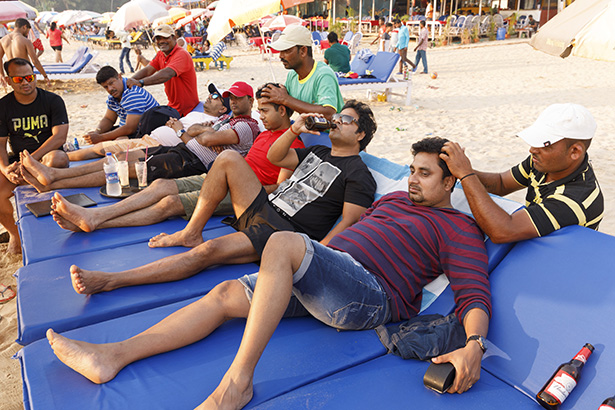

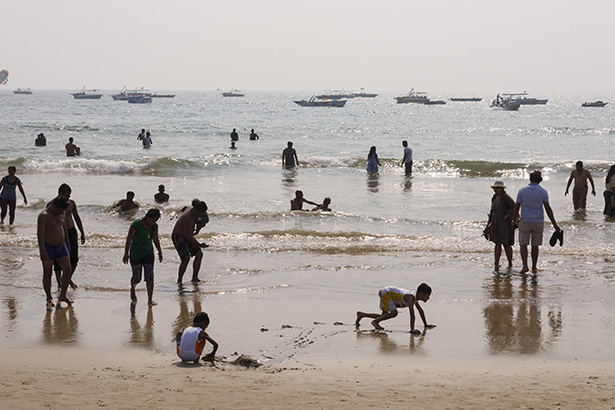
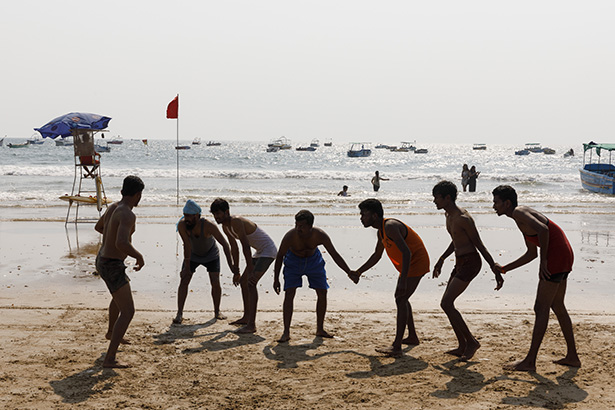
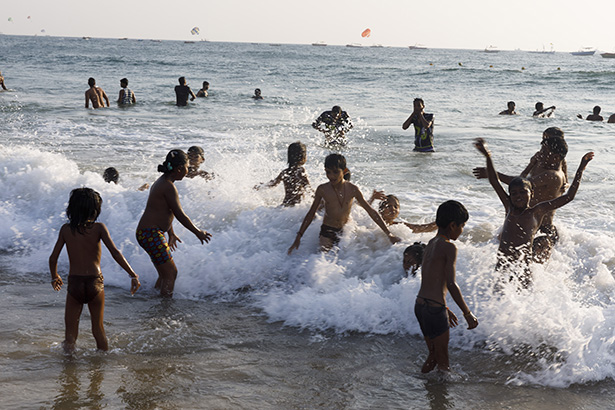
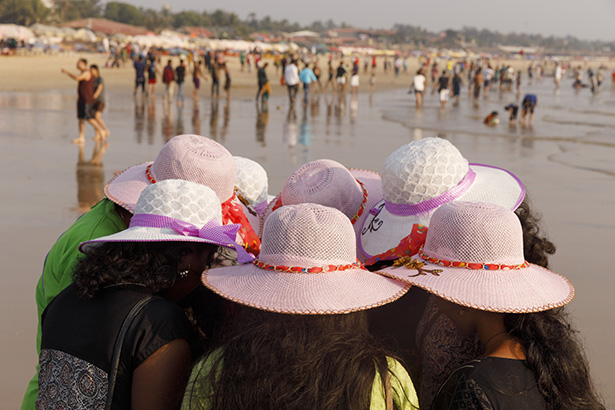
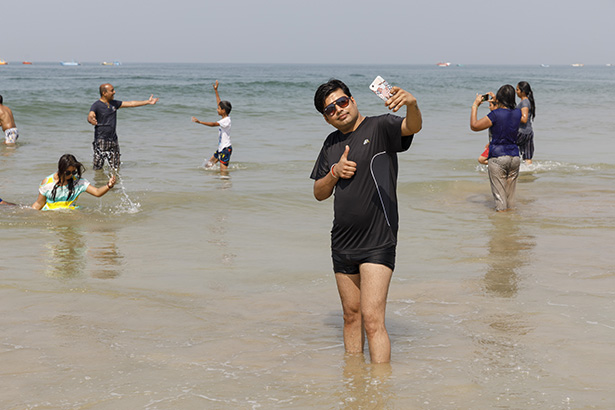
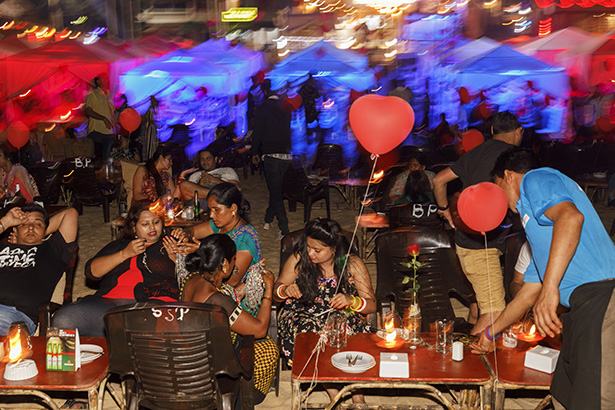

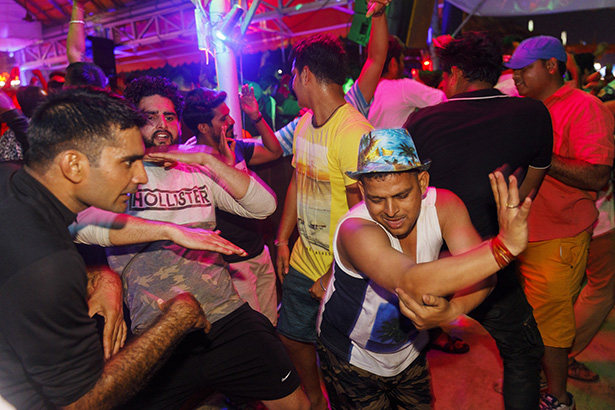

Comments are closed.